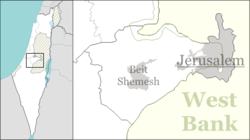Khirbet Qeiyafa

Western gate
|
|
| Alternate name | Elah fortress |
|---|---|
| Coordinates | 31°41′47″N 34°57′27″E / 31.6963°N 34.9575°E |
| History | |
| Founded | 10th-century BCE |
| Periods | Iron Age, Hellenistic |
| Site notes | |
| Excavation dates | 2007 – |
| Archaeologists | Yosef Garfinkel, Saar Ganor |
| Condition | ruin |
| Website | Khirbet Qeiyafa Archaeological Project |
Coordinates: 31°41′47″N 34°57′26″E / 31.69639°N 34.95722°E
Khirbet Qeiyafa (Elah Fortress; Hirbet Kaifeh) is the site of an ancient fortress city overlooking the Elah Valley. The ruins of the fortress were uncovered in 2007, near the Israeli city of Beit Shemesh, 30 km (20 mi) from Jerusalem. It covers nearly 2.5 ha (6 acres) and is encircled by a 700-meter-long (2,300 ft) city wall constructed of stones weighing up to eight tons each. A number of archaeologists have claimed that it might be the biblical city of Sha'arayim or Neta'im and that it might contain the ruins of King David's palace. Others are sceptical, and suggest it might represent either a Philistine or Canaanite fortress.
The meaning of the Arabic name of the site, Khirbet Qeiyafa, is uncertain. Scholars suggest it may mean "the place with a wide view." The modern Hebrew name, מבצר האלה, or The Elah Fortress was suggested by Foundation Stone directors David Willner and Barnea Levi Selavan at a meeting with Garfinkel and Ganor in early 2008. Garfinkel accepted the idea and excavation t-shirts with that name were produced for the 2008 and 2009 seasons. The name derives from the location of the site on the northern bank of Nahal Elah, one of six brooks that flow from the Judean mountains to the coastal plain.
The Elah Fortress lies just inside a north-south ridge of hills separating Philistia and Gath to the west from Judea to the east. The ridge also includes the site currently identified as Tel Azekah. Past this ridge is a series of connecting valleys between two parallel groups of hills. Tel Sokho lies on the southern ridge with Tel Adullam behind it. The Elah Fortress is situated on the northern ridge, overlooking several valleys with a clear view of the Judean Mountains. Behind it to the northeast is Tel Yarmut. From the topography, archaeologists believe this was the location of the cities of Adullam, Sokho, Azekah and Yarmut cited in Joshua 15:35. These valleys formed the border between Philistia and Judea.
...
Wikipedia

